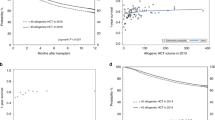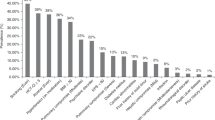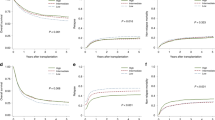Abstract
The association between hospital capacity and survival after allogeneic bone marrow transplantation (allo-BMT) was examined using the dataset accumulated by the Japan Society of Hematopoietic Cell Transplantations (JSHCT). The subjects were 3134 patients who received first allo-BMTs between 1991 and 1997 reported to the JSHCT. They were divided into three groups by cumulative hospital experience of allo-BMTs: low volume (capacity) (LV; ⩽25 cases), moderate volume (capacity) (MV; 26–75 cases) and high volume (capacity) (HV; ⩾76 cases). Using a proportional hazards model, the association of hospital experience with early survival at day 100 (D100S), and overall survival (OS) were examined. For leukemia patients, leukemia-free survival (LFS) was also analyzed. When HV was defined as the reference group, the hazard ratios (HRs) of OS for all subjects were 1.10 (95% confidence interval; 0.97–1.25) for MV and 1.25 for LV (1.08–1.44). The HRs with D100S were 1.20 (0.96–1.51) for MV and 1.40 (1.08–1.80) for LV. Larger values were observed for OS and D100S in cases of leukemia. Survival after BMT from sibling donors was clearly influenced by hospital experience, but this was not the case from unrelated donors. These findings suggest that size of the transplant team should be considered in order to improve the outcome of sibling BMT in general. Bone Marrow Transplantation (2000) 26, 1061–1067.
This is a preview of subscription content, access via your institution
Access options
Subscribe to this journal
Receive 12 print issues and online access
$259.00 per year
only $21.58 per issue
Buy this article
- Purchase on Springer Link
- Instant access to full article PDF
Prices may be subject to local taxes which are calculated during checkout


Similar content being viewed by others
References
Hartz AJ, Krakauer H, Kuhn EM et al. Hospital characteristics and mortality rates New Engl J Med 1989 321: 1720–1725
Davis S, Dahlberg S, Myers M et al. Hodgkin's disease in the United States: a comparison of patient characteristics and survival in the centralized cancer patient data system and the surveillance, epidemiology, and end results program J Natl Cancer Inst 1987 78: 471–478
Hosenpud JD, Breen TJ, Edwards EB et al. The effect of transplant center volume on cardiac transplant outcome JAMA 1994 271: 1844–1849
Birkmeyer JD, Warshaw AL, Finlayson SRG et al. Relationship between hospital volume and late survival after pancreaticoduodenectomy Surgery 1999 126: 178–183
Porter GA, Soskolne CL, Yakimets WW, Newman SC . Surgeon-related factors and outcome in rectal cancer Ann Surg 1998 227: 157–167
Sainsbury R, Haward B, Rider L et al. Influence of clinical workload and patterns of treatment on survival from breast cancer Lancet 1995 345: 1265–1270
Sosa JA, Bowman HM, Gordon TA et al. Importance of hospital volume in the overall management of pancreatic cancer Ann Surg 1998 228: 429–438
Luft HS, Bunker JP, Enthoven AC . Should operations be regionalized? The empirical relation between surgical volume and mortality New Engl J Med 1979 301: 1364–1369
Hannan EL, O'Donnell JF, Kilburn H et al. Investigation of the relationship between volume and mortality for surgical procedures performed in New York State hospitals JAMA 1989 262: 503–510
Berwick DM, Wald DL . Hospital leaders’ opinions of the HCFA mortality data JAMA 1990 263: 247–249
Champlin RE, Gale RP . The role of bone marrow transplantation in the treatment of hematologic malignancies and solid tumors: a critical review of syngeneic autologous and allogeneic transplants Cancer Treat Rep 1984 68: 145–161
Hirabayashi N, Kodera Y, Matsuyama T et al. Bone marrow transplantation in 614 patients: twenty year experience of Nagoya Bone Marrow Transplantation Group (NBMTG) Transplant Proc 1995 27: 1380–1382
Strob RI, Thomas ED, Buckner CD et al. Allogeneic marrow grafting for treatment of aplastic anemia Blood 1974 43: 157–180
Kojima S, Matsuyama T, Kodera Y et al. Allogeneic bone marrow transplantation in 25 patients with severe aplastic anemia Acta Haematol Jpn 1988 51: 705–714
Anderson JE, Appelbaum FR, Storb R . An update on allogeneic marrow transplantation for myelodysplastic syndrome Leuk Lymphoma 1995 17: 95–99
The Japan Society for Hematopoietic Cell Transplantation office of Nationwide Survey . Annual Report of Nationwide Survey 1999. JSHCT monograph vol.2 Nagoya 1999
European Group for bone marrow transplantation . Allogeneic bone marrow transplantation for leukaemia in Europe Lancet 1988 8599: 1379–1382
Horowitz MM, Prezepiorka D, Champlin RE et al. Should HLA-identical sibling bone marrow transplants for leukemia be restricted to large centers? Blood 1992 79: 2771–2774
The Japanese Society of Pediatric Hematology Bone Marrow Transplantation Committee . National registry of bone marrow transplantation in children 1993 Jpn J Pediatr Hematol 1994 8: 32–42
Sasazuki T, Juji T, Morishima Y et al. Effect of matching of class I HLA alleles on clinical outcome after transplantation of hematopoietic stem cells from an unrelated donor New Engl J Med 1998 339: 1177–1185
STATA: computer program. Version 6.0. Stata Corporation: Texas 1999
Kaplan EL, Meier P . Nonparametric estimation for incomplete observations J Am Stat Assoc 1958 53: 457–481
Cox DR . Regression models and life-tables J Roy Stat Soc Series B 1972 34: 187–220
Marks DI, Cullis JO, Ward KN et al. Allogeneic bone marrow transplantation for chronic myeloid leukemia using sibling and volunteer unrelated donors. A comparison of complications in the first two years Ann Intern Med 1993 119: 207–214
Kodera Y, Morishima Y, Hirabayashi N et al. Analysis of 55 transplantations from unrelated volunteer donors facilitated by Tokai Marrow Donor Bank Intern Med 1996 35: 78–83
Kodera Y, Morishima Y, Kato S et al. Analysis of 500 bone marrow transplants from unrelated donors (UR-BMT) facilitated by the Japan Marrow Donor Program: confirmation of UR-BMT as a standard therapy for patients with leukemia and aplastic anemia Bone Marrow Transplant 1999 24: 995–1003
Acknowledgements
This study was conducted as a working group (WG-1) approved by Committee for Nationwide Survey Data Management in the Japan Society for Hematopoietic Cell Transplantation. We are grateful to all doctors participating in the Nationwide Survey.
Author information
Authors and Affiliations
Rights and permissions
About this article
Cite this article
Matsuo, K., Hamajima, N., Morishima, Y. et al. Hospital capacity and post-transplant survival after allogeneic bone marrow transplantation: analysis of data from the Japan Society for Hematopoietic Cell Transplantation. Bone Marrow Transplant 26, 1061–1067 (2000). https://doi.org/10.1038/sj.bmt.1702681
Received:
Accepted:
Published:
Issue Date:
DOI: https://doi.org/10.1038/sj.bmt.1702681
Keywords
This article is cited by
-
Providing both autologous and allogeneic hematopoietic stem cell transplants (HSCT) may have a stronger impact on the outcome of autologous HSCT in adult patients than activity levels or implementation of JACIE at Belgian transplant centres
Bone Marrow Transplantation (2019)
-
The impact of center experience on results of reduced intensity: allogeneic hematopoietic SCT for AML. An analysis from the Acute Leukemia Working Party of the EBMT
Bone Marrow Transplantation (2013)
-
Regional differences exist in allogeneic stem cell transplantation rates for acute leukemia
International Journal of Hematology (2008)
-
Evaluation of centre and period effects in allogeneic haematopoietic stem cell transplantation in France
Bone Marrow Transplantation (2004)
-
Effect of graft-versus-host disease on the outcome of bone marrow transplantation from an HLA-identical sibling donor using GVHD prophylaxis with cyclosporin A and methotrexate
Leukemia (2004)



